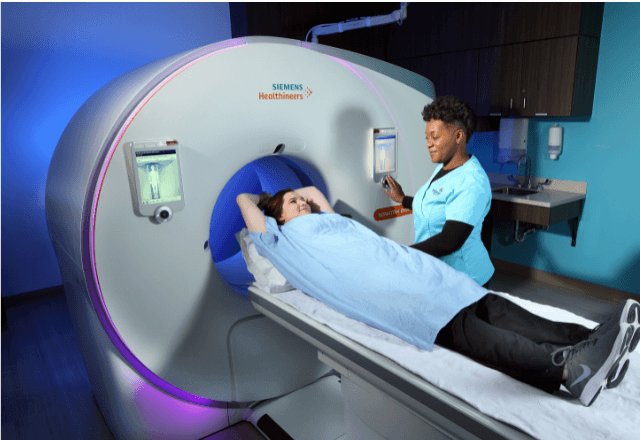MRI Musculoskeletal Imaging in Horses
The Magnetic Resonance Imaging (MRI) technique is a powerful diagnostic tool used to visualize soft tissues in horses. This advanced imaging technology provides detailed, high-resolution images of the musculoskeletal system, which helps veterinarians and equine specialists diagnose injuries and conditions that can be challenging to detect through other means.
Typically, MRI is not a primary screening method but rather a tool used for comprehensive evaluation when other diagnostic methods such as radiography or ultrasonography fail to provide sufficient information. In musculoskeletal imaging, the focus lies on identifying subtle abnormalities in ligaments, tendons, muscles, and bones that may indicate injury or disease.
The equine MRI process involves the horse being placed inside a strong magnetic field while radio waves interact with protons in the body. This interaction generates detailed images of internal structures without the need for ionizing radiation. The procedure is non-invasive and can be performed under general anesthesia, ensuring patient comfort and safety.
MRI plays a crucial role in assessing conditions that are critical to equine health and performance, such as:
- Joint injuries
- Ligament tears
- Tendon ruptures
- Herniated discs (intervertebral disc disease)
- Inflammatory arthritis
- Muscle strain or tear
- Bone fractures and infections
The accuracy of MRI makes it an invaluable tool for making informed decisions about treatment plans, rehabilitation protocols, and surgical interventions. It allows for early detection and precise diagnosis, which is essential in optimizing therapeutic outcomes.
For instance, a veterinarian may use MRI to evaluate the extent of ligament damage before deciding whether conservative treatments or surgery are necessary. Early intervention can significantly improve the prognosis of musculoskeletal injuries in horses, enhancing their recovery rates and reducing long-term complications.
Why It Matters
The importance of MRI in equine musculoskeletal imaging cannot be overstated. Accurate diagnosis is the foundation for effective treatment and rehabilitation plans. Without precise imaging, veterinarians might miss critical details that could alter their approach to patient care.
In the context of performance horses, such as racehorses or show jumpers, timely and accurate diagnosis can mean the difference between a successful career and retirement from competition. Early detection of injuries allows for targeted treatment strategies, potentially extending an athlete’s lifespan in the sport.
Moreover, MRI provides insights into the health status of equine athletes that might not be apparent through other diagnostic methods like X-rays or ultrasonography. This comprehensive approach ensures that horses are returned to optimal performance levels as quickly and safely as possible.
The diagnostic accuracy of MRI also supports research in equine medicine by providing detailed data on musculoskeletal conditions, which can contribute to advancements in treatment protocols and preventive measures.
Benefits
MRI offers several advantages over other imaging techniques when it comes to diagnosing musculoskeletal issues in horses:
- Non-invasive: MRI does not involve ionizing radiation, making it a safer option for equine patients.
- High-resolution images: Provides detailed views of soft tissues, allowing for precise diagnosis and evaluation.
- Precision in identification: Can detect subtle injuries or abnormalities that are difficult to identify through other means.
- Treatment planning: Helps veterinarians develop targeted treatment plans based on the specific findings from the MRI scan.
- Safe for patients: The procedure can be performed under general anesthesia, ensuring patient comfort and safety.
In summary, MRI is a valuable diagnostic tool that enhances the quality of care provided to equine patients. Its ability to provide detailed images of soft tissues without risking ionizing radiation makes it an essential component in modern veterinary practice for musculoskeletal diagnostics.
Why Choose This Test
MRI is a preferred choice for musculoskeletal imaging in horses due to its high-resolution capabilities and the ability to visualize soft tissues without ionizing radiation. Here are some key reasons why MRI stands out:
- Detailed Soft Tissue Imaging: MRI provides superior detail of soft tissues such as ligaments, tendons, muscles, and bones.
- Non-Invasive: The procedure does not involve ionizing radiation, making it a safer option for equine patients.
- Precise Diagnosis: Helps identify subtle abnormalities that might be missed by other diagnostic methods.
- Treatment Planning: Provides comprehensive information to develop tailored treatment and rehabilitation plans.
- Safe Environment: Can be performed under general anesthesia, ensuring patient comfort and safety.
- Research Tool: MRI data contributes significantly to advancements in equine medicine and research.
- Patient Comfort: The procedure is conducted with the horse under general anesthesia, minimizing stress during the scan.
The combination of these factors makes MRI an indispensable tool for diagnosing musculoskeletal issues in horses. Its ability to provide clear, detailed images allows veterinarians and equine specialists to make informed decisions that can lead to better patient outcomes and enhanced quality of care.





